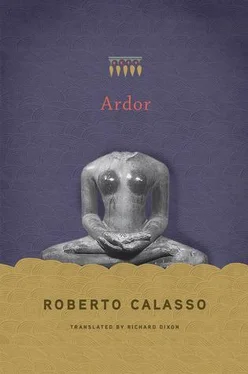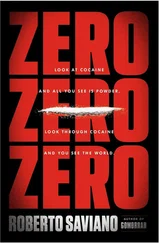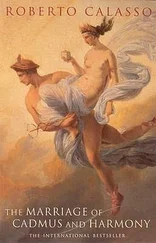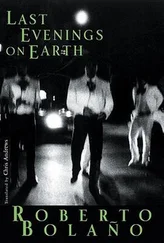* * *
Existence becomes complete only in the presence of soma. The story of the abduction of soma is therefore, so far as humans are concerned, the basis for everything else. A story of release and at the same time of redemption, of a gift which is at the same time the extinction of a debt. It is no surprise, then, that the story of Suparṇī holds within itself the principle that has governed everyone’s life since then: “As soon as he is born, man is born as a person owing a debt to death; when he offers sacrifices, he redeems his person from death, in the same way that Suparṇī redeemed herself for the gods.” These few lines explain with great clarity the reasons behind the radically different assumptions that separate Vedic India from the West. Or at least from the unspoken assumption that, after long elaboration, has ended up becoming Western good sense : that vision of man as a tabula rasa , the wax tablet to which Locke referred. This is the only assumption that allows the complicated mechanisms of society to operate (and for what else — some say — is thought required?). Certainly, the West is also Plato, for whom an equivalent to Vedic “debt” is the recovery of memory. But here we are talking about assumptions that support living in society. And, in particular, of those that are only rendered explicit with the beginnings of the modern age (starting with Locke). At that moment, what had previously worked covertly becomes evident. And it converges in the principal idea of empiricism: the individual as an entirely unprejudiced perceptive apparatus, a being that takes form on the basis of what gradually has an impact on his senses — and nothing else.
“Debt,” ṛṇa , is a key word for Vedic man. His whole life is a continual attempt to settle four debts that weigh upon him from birth: debt to the gods, to the ṛṣis , to his ancestors, to men. They will be paid off, respectively, through sacrifice, through studying the Veda, through procreation, and through offering hospitality. The fact that there are four debts must not lead to confusion. They originate from one debt alone — the debt toward death and its god, Yama. Yet the text here doesn’t name the god, but speaks only of “a debt toward death ( ṛṇaṃ mṛtyoḥ ).”
Life is an asset that death has left in trust for all humans (to be used while it lasts). An asset whose restitution death requires, making man return to death. This is the basis of every life, its innate imbalance. But to this imbalance there is a counterbalance, from the part of the gods: when man offers the oblation to certain divinities, “whoever the divinities are, they consider it as a debt for them to fulfill the desire of the sacrificer at the moment in which he makes the oblation.”
Here, another key word appears: śraddhā , “trust in the effectiveness of ritual.” Which is the Vedic way of expressing our “belief.” And above all, as Benveniste observed, “the exact formal correspondence between the Latin crē-dō and the Sanskrit śrad-dhā is the proof of a very ancient heritage.” The sacrificer, with his defect as an innate debtor, faithfully offers the oblation, in the belief that at that same moment the gods will begin to recognize they have a debt to him. Only the institution of a double obligation — of people to the gods and of the gods to people — ensures that flow which is life itself. By obtaining a credit with the gods, man (namely the sacrificer) delays, postpones, defers the moment when he will have to settle his debt with death. Every action is founded on this double imbalance. On the basis of this imbalance every action acquires meaning.
Malamoud observes that the word ṛṇa , “debt,” apparently has no etymology. The four innate debts, and the very notion of debt, are presented baldly, without explanations — and are destined to go far, remaining alive and powerfully felt much later on, in the world of bhakti , of “devotion,” which claims to do without ritual orthodoxy. To this Malamoud adds, by way of a parallel, that “there is no mythology of indebtedness.” This is surely true, in fact, though with one exception: the story of the two sisters Kadrū and Suparṇī (or, in other texts, Vinatā) and the capture of Soma — a story that is, by no coincidence, the basis for all other Vedic stories. That story is enough to establish the perpetually unequal system of exchange between men and gods. But also between life and death.
* * *
How can men imitate the complex scenario of the capture of Soma? By replicating the last stage: the barter between Vāc and Soma. They offer a cow to a mysterious character (the trader who brings the soma on his cart) so as to purchase that prized item. Everything happens through an equivalence: the cow is Vāc. And the cow is milk. And the milk is gold: “Milk and gold have the same origins, for both are born from Agni’s seed.” The human repetition has nothing of the overwhelming divine theatricality. But it reveals a point that had remained hidden before: that barter — between a female being and a substance — is more accurately a sale, which is carried out through gold, the source of all currency. The first exchange, the first substitution, takes place with something that cannot, by its very nature, be substituted: soma , the substance that is a state of being, a state of mind that can be attained only through it.
* * *
But with the purchase of soma not everything is resolved. Another scene is included as a grotesque and enigmatic prelude. The first sale was a sham. In just the same way that Vāc had been offered in barter to the Gandharvas to obtain Soma but then — thanks to the wooing ploy — had to be returned to the gods, so too the cow that men use to buy the soma from the trader returns in the end to them. How? Because, at the end of the haggling, the soma trader is given a thrashing and the cow is led away. That which on the divine stage was a delightful and subtle exchange of words becomes an act of pure violence on the human stage. It is as if the act of selling was too serious to be entirely accepted. A brutal act must cancel out its consequences. But this only makes things worse — it is a fatal step.
Selling and measuring, those two irreversible gestures, can be carried out only after the arrival of the royal guest, the soma plant on the trader’s cart, as if only soma was capable of providing a standard, to which every exchange, every measure can be related: “He [the adhvaryu ] then spreads out the cloth folded in two or in four, with the fringe toward east or toward north. On it he measures the king: and, since he measures the king, there is therefore a measure, the measure among men as well as any other measure.” Soma, the being that is pure quality, discernible only as an intensity of mind, exalted by the juice of that plant, guarantees and establishes the world of quantity, where everything is measured and is sold. What would happen without soma ? Selling and measuring would continue, but dictated by the rule of “false weight,” as Joseph Roth would say.
The adhvaryu who officiated at the soma ceremony kept a piece of gold tied to his finger. Why? In the human world — the world of untruth— soma bursts in like a palpable truth, the only substance flowing from the other world, the world of the gods, who are truth. This justifies the precautions, the ways they use to approach it. The officiants move around it as if it were a red-hot mass. They know that every gesture of theirs can harm it, but can also harm the truth, which is there before them, defenseless like any plant. And it’s a guest.
Читать дальше












